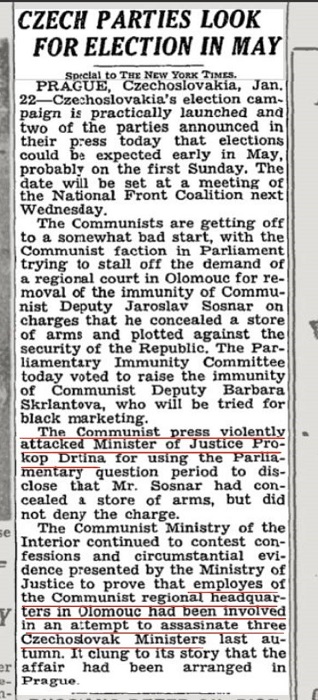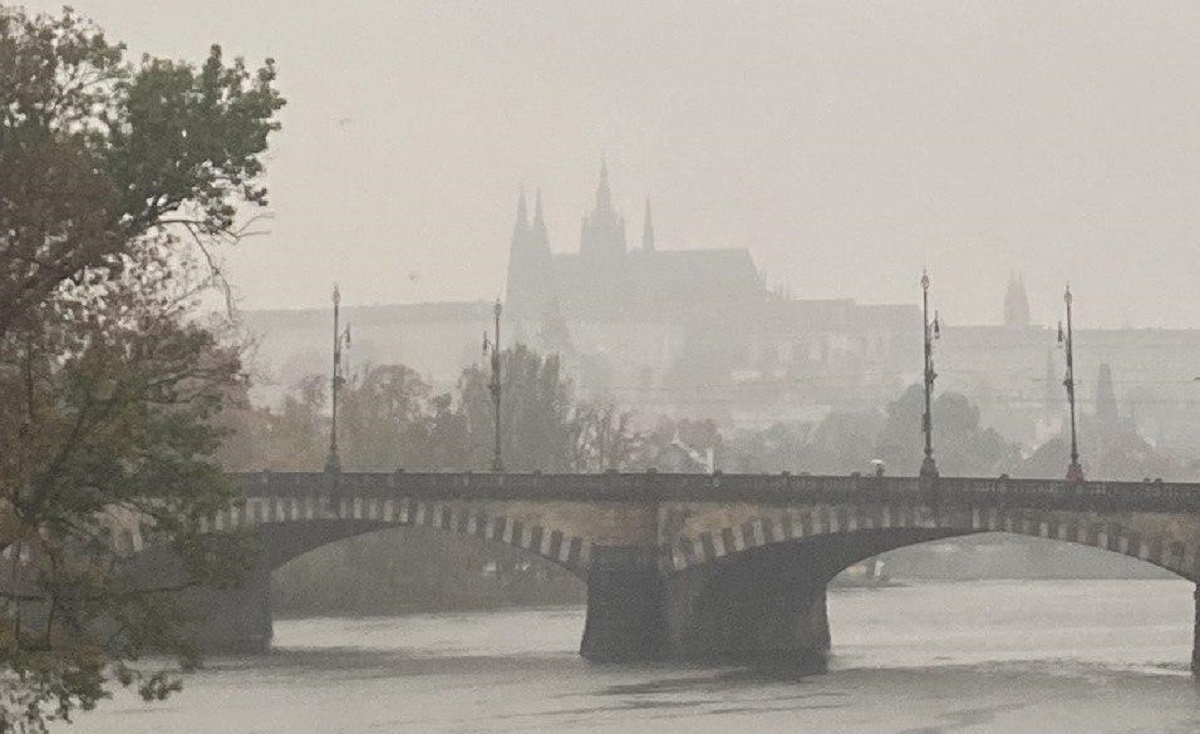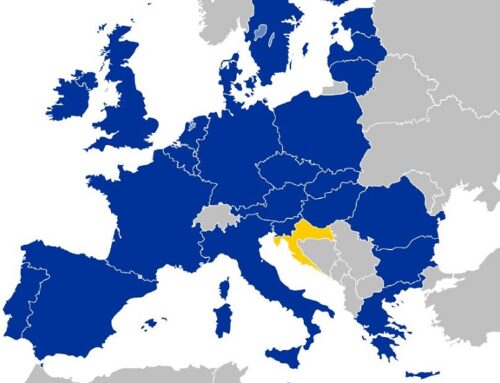Introduction
In the aftermath of the fall of the Iron Curtain, the “end of history” seemed palpable—a belief that democracy had triumphed decisively. Yet, with hindsight, history never truly finds its conclusion. Across former communist strongholds in Europe, the echoes of democratic backsliding have grown louder in recent years – Slovakia, Poland and Hungary. This resonates with the haunting memory of the Czechoslovak Communist Coup of 1948. To grasp this significance, one must first immerse oneself in the rich national past – the idealistic democracy of the First Republic and its subsequent transformation into the last enduring democracy amidst the Cold War’s frontlines until February 1948. The Czechoslovak experience serves as a testament to the fragility of democratic systems.
The 1948 coup is a complex case, and perhaps that’s exactly what makes it most suitable to exemplify that democracy does die in darkness.
First Republic. Roots of Democracy
Czechoslovakia was known as the linchpin of the Versailles order.[1] Tomas Garrigue Masaryk, the first President, and the foreign minister, Evdard Benes understood this as no other, highlighting the moral and strategic necessity of Czechoslovakia to Western audiences through Orbis publishing.[2] The national myth was centred around the noble and tolerant democracy of the Czechoslovaks – an island of rationalism, and fair-mindedness amid fascist-slipping Europe.[3] Masaryk appealed to Hussites as proto-democracy, capturing the truly egalitarian spirit of the Czechs.[4] Gellner and Orzoff point at the internationalist premise of Masaryk’s myth.[5] Internationalist premise aside, Czechoslovakia adopted universal suffrage in 1920 – all citizens had the right to vote and be elected regardless of gender and as Tony Judt highlighted, the only hospitable place for Jews in the early 1920s Eastern Europe was Czechoslovakia.[6]
Post-war elections. Democratically elected communists?
Communism and fascism were two main opposing forms of radical activism in the early half of the twentieth century.[7] Despite having the strongest national bourgeoisie in Eastern Europe, Czechoslovakia saw the rise of fascism as a major concern.[8] It would result in the end of the country’s existence and multiethnic tolerance, a proud trait of the Czechoslovak state.[9] Given the values of the First Republic, the flourishing of the Czechoslovak left is unsurprising. In 1925, KSC (Komunistická strana Československa, or Communist Party of Czechoslovakia) took second place in the elections, receiving 41 seats in the Parliament. By 1928, KSC becomes the second largest section of the Communist International. Communist parties experienced two obstacles during this period. Firstly, the internationalist nature of ideology and ties to Moscow implied agency from a foreign power. Being a communist translates to being disloyal to one’s patria. Secondly, intense atheism was an electoral liability. These concerns about communism perished with the 1938 Munich Agreement. It was the communist party’s golden ticket. They presented themselves as the true defenders of liberties, unlike the bourgeois Western powers, which left Czechoslovakia to Nazi Germany’s devices. In 1938, the Comintern published a ‘manifesto,’ highlighting Soviet readiness to defend Czechoslovakia, Western betrayal of the small nations and asserting the missed possibility of saving Czechoslovakia.[10]
In 1945 after almost two years of negotiations, a National Front was formed, combining KSC leaders (exiled in Moscow) and Benes (exiled in London). The Front’s Kosice program was an anti-Nazi coalition aimed at securing Czechoslovak independence. After the Second World War, the most popular Czechoslovak party – the Agrarians (RSZML) were dismissed for collaborating with the Nazis. Slovak Republic’s most popular party – the Hlinka Party (SLS) faced the same destiny. Agrarians, opposing Hrad, in partnership with fascist collaborators, dismantled the First Republic. The Hlinka Party collaboration made Slovakia Nazi Germany’s cliental state.
Benes’ last London radio address expressed a rather favourable view of the Soviets, placing them on the good side in the Nazi/Soviet dichotomy: “For the Red Army stands practically before the gates of Berlina and with it comes…real and unavoidable justice and retribution, awaited by us for six years.”[11] In Kosice, KSC enjoyed the most powerful position within the National Front. Its position was strengthened by its novelty. Communists bore no responsibility for the mistakes of the First Republic, including Munich. The Soviet alliance with Czechoslovakia in 1943 and the Red Army’s success aided the popularity of KSC. Ban on the re-establishment of the Agrarians, expulsion of the Sudeten Germans, historically opposing the left, the success of the Soviet army, attempts by KSC to organise resistance and significantly pay for those efforts, heightened anti-fascist sentiment and quite far-left elements of the Kosice program (nationalisation of the major industries, energy utilities, banks and insurance companies) guaranteed a dashing victory for Czechoslovak communists in 1946 with 38 per cent vote.[12]
KSC’s accession to power is a unique case in the region. Firstly, it was the only democratic and legal case. The London government and Bense gained recognition in Moscow as the Czechoslovak military unit was organised under the operational control of the Red Army. Crucially, Benes promised Maisky to cede Ruthenia to the USSR after the restoration of independence.[13] Secondly, Czechoslovakia was liberated by both the Soviet and American armies and both armies were recalled by the end of 1945.[14] Despite the post-war elections encapsulating a shift to the left, Benes’ presidency guaranteed a balance of power. Igor Lukes underscores the importance of the Czechoslovak case to the Western powers, which closely observed any developments within the political field.[15] Success or failure of the last multi-party democracy in the region would determine the possibility of coexistence with the Soviets.[16]Czechoslovak history and geographical position made a “barometer of east-west relations.”[17] Roosevelt chose Laurence A. Steinhardt as his ambassador to Czechoslovakia. He was a seasoned diplomat, who served in Moscow and proved his shrewd tactics during the Ankara term.[18]
Vaclav Nosek and the start of the secret police
KCS have been in a position of strength since Kosice. The elections bolstered their confidence (and Soviet assertion). Even though the government was non-communist in its majority, nine communists to seventeen non-communists, the Ministries of Interior, Information and Agriculture were under KSC control. Ministers of Education and Defence were open Communist sympathisers. Jan Masaryk was the only non-leftist minister.
The crucial element of the success of the 1948 coup is related to the communist control of the police, armed forces and, perhaps, most notably, the Ministry of Interior with Vaclav Nosek as its head. Nosek’s policy was anything but popular – output had to be increased without any increase in wages, and farmers objected the prospect of collectivisation.[19] Moscow provided instructions and advisors for a remarkable variety of purposes.[20] Czechoslovaks, however, remembered the industrial success and high standards of education that put the First Republic in the ten most developed in the world.[21] Thus, the communist popularity has been decreasing exponentially.[22] The general expectation was the defeat of the Communist Party at the 1948 elections.[23] Gottwald and Slansky publicly promised a 51 per cent victory.[24] The promise failed to match the polls that hinted more towards a pluralist victory with KCS getting around 30 per cent, such a scenario amounted to defeat for Moscow’s and party plans.[25] Zhdanov personally assessed the situation as dim for the Soviets, singling out the Czechoslovak case as the only one “where the power contest still remains undecided.”[26] This undoubtedly contributed to the planning of the coup; the Soviets could not allow Czechoslovakia to be decoupled from their power centre.[27] After all, the high industrialisation of Czechoslovakia and its raw resources were of great avail to the highly militarised USSR. Moscow’s main source of uranium, which is required for the development and production of nuclear weapons, came from Czechoslovakia.[28] In the 1980s, Czechoslovakia and the Soviet Union were the only builders of heavy-duty nuclear power equipment.[29]
Totalitarianism is a twentieth-century invention. What makes it unique is the omnipresence of the state in every sphere of life. This in large is enabled by the emergence of secret police as an institution, pioneered by Lenin’s Cheka. The Czechoslovak communists, upon taking control of the Ministry of Interior, utilized police terror as a means to destabilize various institutions and society itself, fostering mass atomization to consolidate their power.[30] The KCS realised that their future may depend on the security apparatus, gradually filling the Ministry of Interior with party members.[31]
In January 1948, the main point of parliamentary contention among democrats and communists was an assassination attempt on three democratic ministers, traces of which led to Alexader Cepicka, a high-ranking communist party official.[32] Ministry of Interior refused to launch a criminal investigation.[33]
Western impotence or Steinhardt’s 200 days out of the office
Lukes asserts that by the time Steinhardt reached Prague, his passion for diplomatic affairs had cooled off.[34] His reports to the Department of State were ill-informed and his forecasting was naive.[35] In spite of removal of eight police officers due to the absence of party membership and instances of terrorism directed at government officials, Steinhardt persisted in viewing the situation through an optimistic lens.[36] The word “crisis” appears on the chargé’s report only on February 18, 1948 (less than a week before the coup).[37] Why was the chargé reporting, instead of Steinhardt? Amidst concerning signs of significant democratic regression, Steinhardt was absent from the office for approximately 200 days during the critical period from 1947 to February 1948.[38] Democratic Czechoslovakia was crucial, as it would indicate the possibility of democracy and independence in the otherwise totalitarian Soviet-controlled region. The return to the roots of the First Republic and its Anglo-American values would have sent a powerful message to the Eastern Bloc and boosted Western prestige, a much-required enterprise post-Munich. High-ranking Soviet officials acknowledged the fragility of their position in Czechoslovakia. History does not tolerate the subjunctive mood and there is no knowing whether democratic Czechoslovakia could have returned. However, what could be asserted is that Steinhard’s absence, especially at formal ceremonies, where a Soviet ambassador substituted him, sent a signal to the Kremlin about the dearth of American backing and subsequently untied KCS’ hands. Neither did Steinhardts’ conclusions help the country’s independence, “the Communists would never be able to take power by force because roots of democracy were too deep in Czechoslovakia.”[39] The New York Times illustrated a better grasp of the situation than the American mission (Image 1).[40]

Despite Molotov’s initial encouragement of the Czechoslovak participation in Marshall’s Plan, the Soviets never intended for American investment to reach Prague.[41] Recognizing their vulnerability, Americans sought to influence Czechoslovak politics through alternative channels using their economic power.[42] However, the American mission concluded that premature loans would come across as “cheap” and would weaken anti-communist forces.[43] Instead, George Marshall’s initiative was implemented – stipends and fellowships for Czechoslovaks in American universities.[44] Young Czechoslovaks who managed to learn English during the Nazi occupation were few and far between. The minimal efforts by the Americans made an impression that Czechoslovakia was being abandoned by the West, while the Soviets were providing aid.[45] Contrary to Steinhardt, American and British diplomats were well aware of the situation, with British diplomat, Dixon, hinting to Drtina about a forthcoming Communist dictatorship.[46] Both diplomats made it clear that there should be no expectation of their respective countries participating.
American staff realized that the Communist position was struggling – the promised 51 per cent victory was unachievable, general support had died down, and inefficiencies of the system were felt and criticised by the public. Nathaniel Davis wrote that the Communist loss of the 1948 elections was “clear.”[47] However, the diplomatic residents of the Schönbron palace failed to realize that one can’t be full with democratic roots, democracy requires constant action. Unfortunately, the Czechoslovaks felt Bob Woodward’s and The Washington Post’s ‘Democracy Dies in Darkness’ on their skin.
Communists decided to act
Understanding the instability of their position, communists decided not to test their destiny at the February elections and began their prompt overtake campaign. Importantly, the KSC finally received a green light from Moscow. After the popular front approach failed in France and Italy, Stalin gave up the idea of the parliamentary path for the Czechoslovak Communists.[48] Slansky returned from Moscow with the final plan for the seizure of power.[49]
KSC leaders took to Radio Prague and Cas periodical to blast anti-democratic propaganda, portraying non-communist parliamentarians as plotters.[50] The police control proved useful as the Communist-led police guards monitored the surroundings of the post offices, radio and train stations.[51] Gottwald instructed Nosek to avoid public appearances on the premise of disease. The absence was utilised to avoid any resolutions about the fired policemen.[52] The government meeting regarding the case concluded with Gottwald accusing democrats of a coup d’etat.[53] American chargé insisted that communists wouldn’t skip the upcoming elections.[54] The communists aimed to sustain this facade, recognising the unpopularity of the Soviet system. They sought to create an illusion of popular backing, resorting to people’s demonstrations when it became clear that elections were no longer an option.[55]
On February 19, a plane landed from Moscow, outpacing Steinhardt’s landing from Paris, on board was Valerian Zorin and a symbolic message about Soviet intentions to American and Czechoslovak democratic counterparts.[56] This was followed by the Red Army manoeuvring along the Czechoslovak border and an editorial in Pravda titling democrats as “reactionaries.”[57] The only title that could overpower “reactionary” in Soviet propaganda vocabulary was probably a “cosmopolitan,” Pasternak’s Noble Prize was “Reactionary Propaganda Uproar over a Literary Weed.”[58] Along with mass demonstrations, KSC mobilised People’s Militias (Lidové Milice, Zádovní Straze) to intimidate opponents.[59]
Intelligentsia – waltzing into the night and new dictator state
On February 20, following the claim of a communist dictatorship aspiration, twelve ministers resigned.[60] The plan was to achieve failure of government with consequent elections revealing the unpopularity of KSC.[61] The flawed coordination of the democratic coalition resulted in fourteen ministers staying in power, chopping the plan up at its root.[62] Jan Masaryk kept his post, as did many Social Democrats, who feared the dissolution of their party in light of the resignation.[63] KSC could not imagine a better scenario; Gottwald started his search for suitable candidates for the freshly emptied governmental seats.[64]
The communist atrocities did not go unnoticed, democrats asserted their opposition on a procedural matter.[65] Unfortunately, that is where the efforts stopped. Lukes describes the missed opportunity when talking about Jan Masaryk: “The man whose name alone would have brought masses to the streets and inspired to defend democracy had decided to hide behind a fake cold.”[66] Gottwald’s plan to isolate democrats was successful. General Pika, famous for his courage and guardianship of democracy, summed up his position with “I am sick and old, and it’s all over.”[67] While KSC leaders were presiding over a gathering of 8000 trade unionists, the democrats were waltzing into the night or admiring the athleticism of skiers and the beauty of the Tatras at the championship with many oblivious of the nationwide rallies.[68] This was on February 22. On February 23, the country woke up to Nosek declaring all existing passports invalid.[69] Democracy was dead. In two days, Venceslas Square saw Gottwald proclaim Benes’s acceptance of the new government – the last glimmer of democracy in Eastern Bloc died out. To repeat Igor Lukes’ question, how could it have been so easy?
The Czechoslovak coup d’état serves as a stark exemplification of democratic fragility.. The gradual collapse of democratic institutions and the complete abolition of democracy within two days highlight the importance of safeguarding democracy. Firstly, it underscores that no democracy is inherently exceptional or immune to authoritarian threats. Democracy demands continuous vigilance, active engagement, and a commitment to defend shared democratic values. Complacency and failure to mobilise around fundamental democratic ideals can leave democracy vulnerable to erosion. Secondly, the erosion of democratic norms and the subversion of key institutions, like the Ministry of Interior, exposes the vulnerability of institutions to partisan manipulation. Strengthening institutional resilience, ensuring their independence, and maintaining separation of powers are effective cures against authoritarian disease. Lastly, the case emphasizes the importance of international engagement and cooperation in upholding democratic values. Beyond military aid, diplomacy and foreign policy, equipped with regional expertise, must promote democratic values through cultural exchange and education, especially in the face of global challenges posed by nations that disregard the rule-based order.
The Czechoslovak example serves as a timely reminder of the need for constant vigilance, institutional strengthening, and active international engagement to protect and preserve democracy in a rapidly changing global landscape.
References:
[1]Andrea Orzoff, Battle for the Castle, Oxford University Press, 2009, p. 4.
[2]Orzoff, Battle for the Castle, pp. 3-4
[3]Orzoff, Battle for the Castle, p.11.
[4] Gellner, Nations and Nationalism, Blackwell, 2006, p. 99.
[5] Gellner, Nations and Nationalism, p.99; Orzoff, Battle for the Castle, p. 5.
[6]Tony Judt and Timothy Snyder, Penguin Press, 2012, Thinking Twentieth Century, Chapter: The Names Remain: Jewish Questioner, p. 25 (e-book). Throughout this paper Czechoslovakia is referred to as Eastern Europe. This is due to the language of the scholars writing on the topic within the framework of Eastern Bloc.
[7]Robert Bideleux and Ian Jeffries, A History of Eastern Europe, Routledge, p. 500
[8]Robert Bideleux and Ian Jeffries, A History of Eastern Europe,p. 499.
[9]Robert Bideleux and Ian Jeffries, A History of Eastern Europe,p. 499.
[10]Robert Bideleux and Ian Jeffries, A History of Eastern Europe,p. 510.
[11]Orzoff, Battle for the Castle, p. 203.
[12]Orzoff, Battle for the Castle, p.. 207.
[13]Mary Heinman, Czechoslovakia: The State That Failed. Yale University Press, p. 123.
[14]Ivan T. Berend, Central and Eastern Europe, Cambridge University Press, p. 19.
[15]Igor Lukes, The 1948 Coup d’Etat in Prague through the Eyes of the American Ebassy, Routledge, p. 432.
[16]Lukes, The 1948 Coup d’Etat, p. 431.
[17]Lukes, The 1948 Coup d’Etat, p. 432.
[18]Lukes, The 1948 Coup d’Etat, p. 432.
[19] Robert C. Grogin, Natural Enemies: The United States and the Soviet Union in the Cold War, 1917–1991. Lexington Books, pp. 133-134.
[20]Norman Naimark, “The Sovietization of Eastern Europe” in The Camdridge History of the Cold War by Leffler and Westad,p.194.
[21] https://eurydice.eacea.ec.europa.eu/national-education-systems/czechia/historical-development
[22]Naimark, “The Sovietization of Eastern Europe,” p. 182.
[23]Grogin, Natural Enemies, p. 134.
[24]Lukes, The 1948 Coup d’Etat, p. 435.
[25]Lukes, The 1948 Coup d’Etat, p. 435.
[26]Grogin, Natural Enemies, p. 134.
[27]Naimark, “The Sovietization of Eastern Europe,” p. 182.
[28] Benn Steil, The Marshall Plan (Oxford: Oxford University Press, 2021), p. 235.
[29]Ihor Gadwiak, Czechoslovakia: a Country study. Chapter 3. Economy, p. 152 https://tile.loc.gov/storage-services/master/frd/frdcstdy/cz/czechoslovakiaco00gawd/czechoslovakiaco00gawd.pdf
[30]Hannah Arendt, The Origins of Totalitarianism, Penguin Classics, p.323.
[31]Lukes, The 1948 Coup d’Etat, p. 436.
[32]Lukes, The 1948 Coup d’Etat, p. 434.
[33]Orzoff, Battle for the Castle, p. 214.
[34]Lukes, The 1948 Coup d’Etat, p. 432.
[35]Lukes, The 1948 Coup d’Etat, p. 432.
[36]Orzoff, Battle for the Castle, p. 215.
[37]Lukes, The 1948 Coup d’Etat, p. 437.
[38]Lukes, The 1948 Coup d’Etat, p. 433.
[39]Lukes, The 1948 Coup d’Etat, p. 437.
[40]Lukes, The 1948 Coup d’Etat, p. 434.
[41] Steil, The Marshall Plan, p. 119.
[42]Daniel Yergin, Shattered Peace, Penguin Books, pp. 345-344.
[43]Daniel Yergin, Shattered Peace, p. 345; Lukes, The 1948 Coup d’Etat, pp. 433-435.
[44]Lukes, The 1948 Coup d’Etat, p. 435.
[45]Daniel Yergin, Shattered Peace, p. 345.
[46]Lukes, The 1948 Coup d’Etat, pp. 436-437.
[47]Lukes, The 1948 Coup d’Etat, p. 435.
[48]Grogin, Natural Enemies, p. 134.
[49]Grogin, Natural Enemies, p. 134.
[50]Lukes, The 1948 Coup d’Etat, p. 434.
[51]Orzoff, Battle for the Castle, p. 215.
[52]Lukes, The 1948 Coup d’Etat, p. 437.
[53]Lukes, The 1948 Coup d’Etat, p. 437.
[54]Lukes, The 1948 Coup d’Etat, p. 437.
[55]Matt Killingsworth, Civil Society in Communist Eastern Europe. ECPR Press, pp. 51-55.
[56]Lukes, The 1948 Coup d’Etat, p. 438.
[57]Lukes, The 1948 Coup d’Etat, p. 439.
[58]Olga Ivinskaya, A Captive of Time: My Years with Pasternak, Doubleday, p. 224.
[59]https://armada.vojenstvi.cz/povalecna/studie-a-materialy/lidove-milice-v-ceskoslovensku-v-letech-1948-az-1989.htm
[60]Lukes, The 1948 Coup d’Etat, p. 439.
[61]Lukes, The 1948 Coup d’Etat, p. 439.
[62]Lukes, The 1948 Coup d’Etat, p. 439.
[63]Lukes, The 1948 Coup d’Etat, p. 439.
[64]Lukes, The 1948 Coup d’Etat, p. 439.
[65]Lukes, The 1948 Coup d’Etat, p. 440.
[66]Lukes, The 1948 Coup d’Etat, p. 440.
[67]Lukes, The 1948 Coup d’Etat, p. 440.
[68]Lukes, The 1948 Coup d’Etat, p. 441.
[69]Lukes, The 1948 Coup d’Etat, p. 442.





